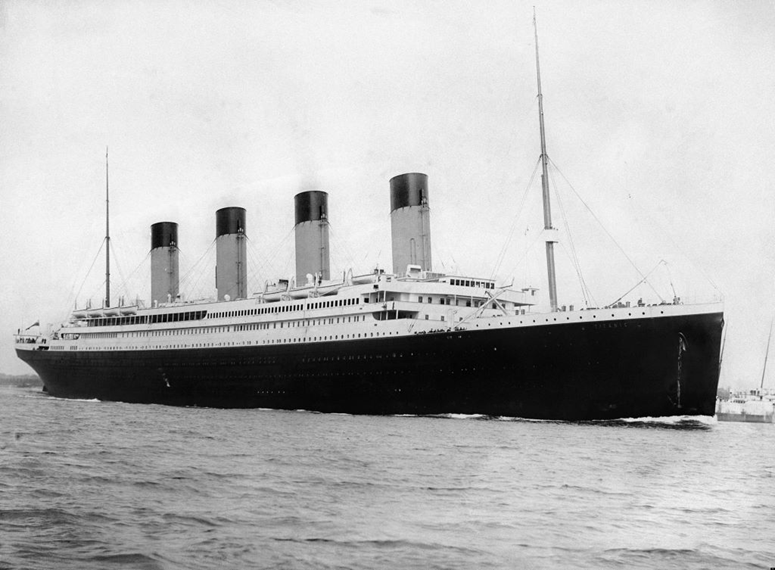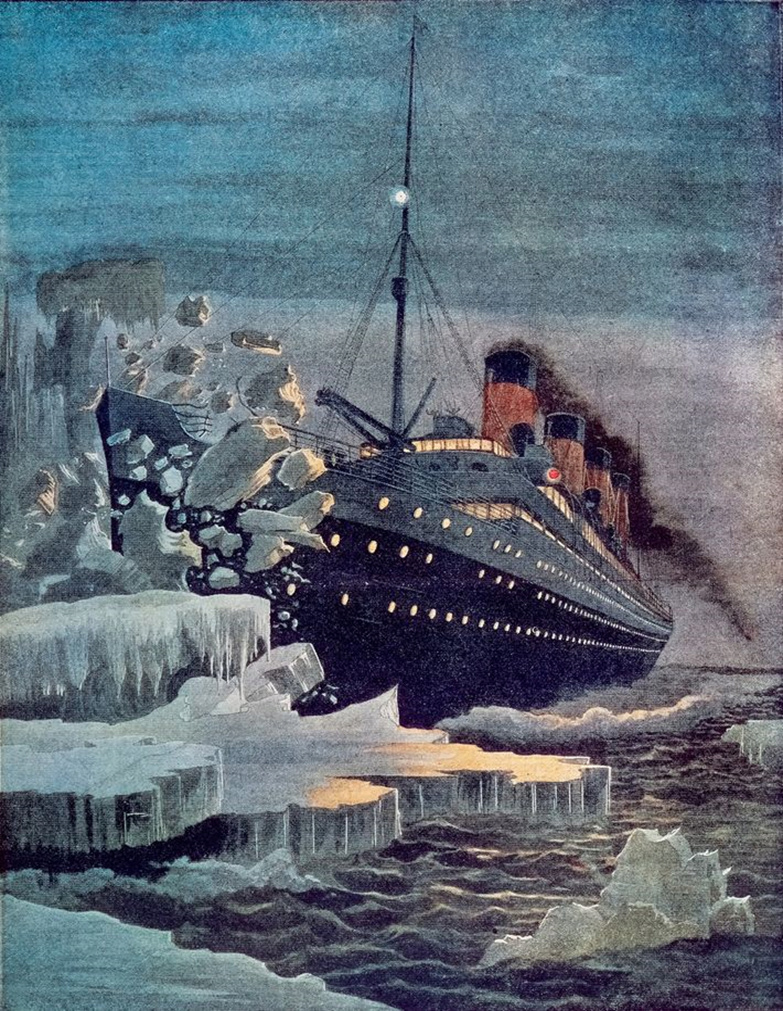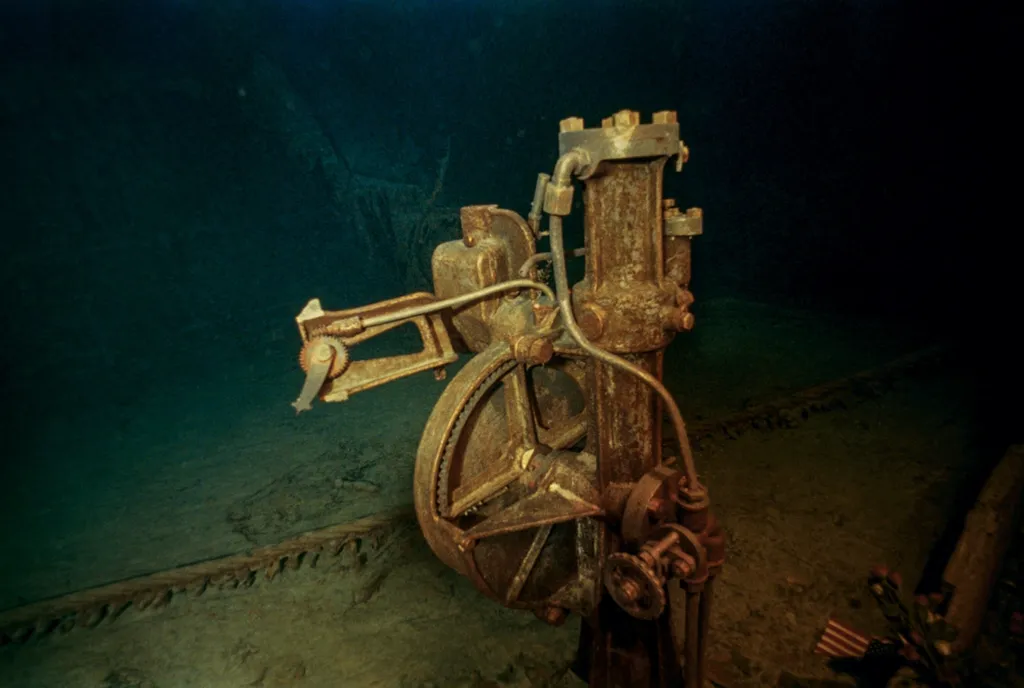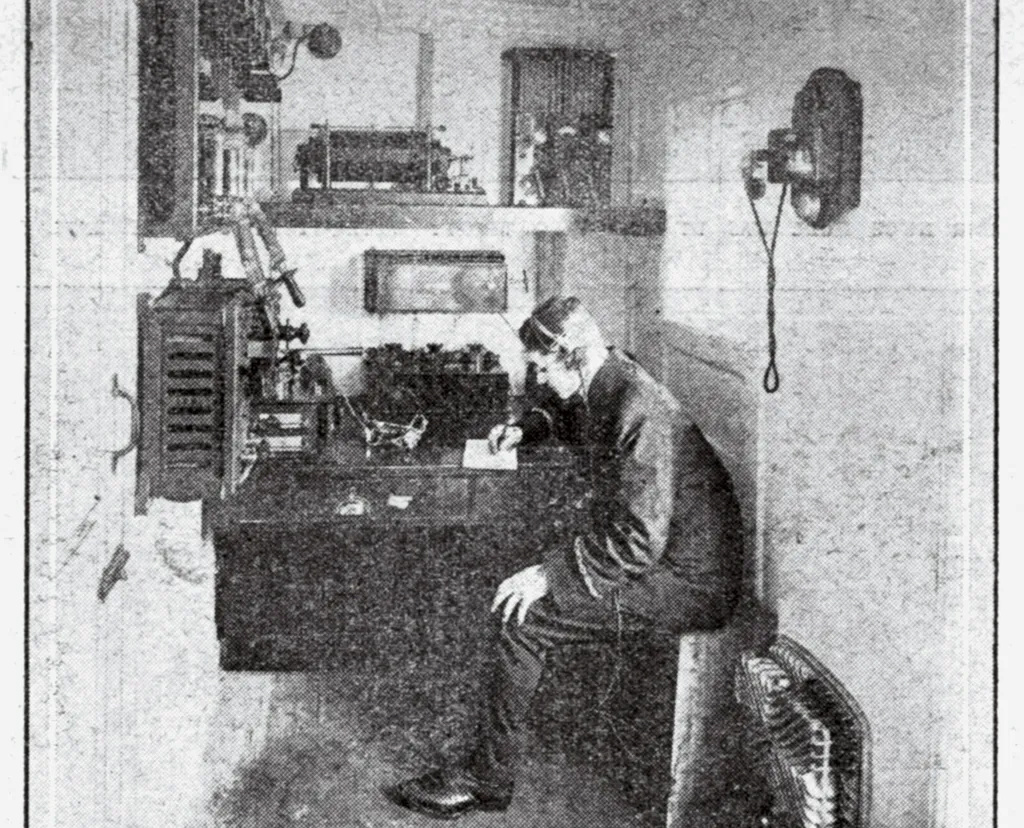30seconds was enough to stop the Titanic from sinking

An imagined scene of the sinking of the "Titanic" (Getty Images)
Coincidences preceded the disaster... An outburst of anger made night vision binoculars out of reach, consideration for the wealthy reduced the number of rescue boats, and the "curse of the pharaohs" was on board the ship
On the evening of April 14, 1912, the Californian, according to the testimony of her captain and crew, was on her way from London to Boston when she found herself in the same ice-laden part of the North Atlantic as the Titanic, which was On her first voyage from London to New York, that voyage was accompanied by unprecedented celebrations of this enormous ship, which some said was "unsinkable".
In contrast to the captain of the "Titanic", Edward Smith, who led his ship to perish by increasing its speed despite the presence of ice, the captain of the "Californian" was a very careful and careful man, so he ordered his ship to be stopped for the night.
At about 11:00 p.m., the Californian's radio operator, Cyril Evans, sent an unofficial message to the Titanic, which he knew was somewhere in the area.
The letter bore a few words: "We are surrounded by ice and we have stopped."
In his great book "Puzzling Historical Mysteries", the American investigative journalist, Paul Aron, describes the reaction of the wireless operator on the deck of the "Titanic", Jack Phillips, who was disturbed by the interruption, as he was busy all day sending messages to the ship's wealthy passengers, and he had no Time to chatter and he says, "Shut up, shut up, you're confusing me."
Evans was so frustrated by the dry response he received from the Titanic operator that, having been up all day, he turned off his machine and went to sleep.
It was a godsend, so to speak, that there was no other radio operator on board his ship, and so she was out of range when Titanic began to send her distress call, at about a quarter past twelve, for there was no one awake who could Hear it aboard the Californian.
The matter did not stop at the wireless messages that were sent from one and the worker of the second refused to pay attention to them. Rather, the scene extended to the neglect of the "Californian" officers with the light missiles that were launched from the "Titanic", and the "Californian" captain was not awakened, until about four o'clock, after they sensed Some concern and uneasiness about photonic missiles.

Time passed quickly, and the "Titanic" sank to the bottom of the ocean, drowning with it about 1,500 VIP passengers between Europe and America.
The lines of "Paul Aron" invite us to a radical question that is still stuck within the "Titanic" puzzle: Was it easy to save that giant ship, if the wireless operator on it took the message of the nearby ship, and informed the captain of his ship, and the world avoided this painful disaster for a hundred years? And will it last long?
The most interesting thing about this story is that the Titanic received several warnings from ships other than the Californian, warning it of the presence of huge numbers of ice blocks in the northern part of the Atlantic Ocean, including the warnings of the ship, Missaya, which warned it sternly about the danger of sailing at night due to poor visibility. But it is clear that those warnings from the Department of Wireless Communications were ignored, so that fate struck its blow, and there may have been different chances for the survival of the "Titanic", and changing the course of history if it had been listened.

The ship "Titanic" before taking off for the United States (Encyclopedia Britannica)
?Where did the key to the Titanic's binoculars go
On the eve of April 4th, the sailor, Frederick Fleet, took over the deck of the giant ship. Fleet was an experienced sailor who had trained on a training ship since the age of twelve.
It was very cold that night at the observation deck during the night when Frederick was the first to see a dark mass in the water and immediately reported the danger to his superiors. The first officer replied immediately, but it was too late.
Frederick was one of the 706 individuals who survived the disaster, while about 1517 drowned. He later stated in the investigations conducted to find out the causes of the accident that he did not have binoculars on hand.
Does this reason seem absurd, in the sense that a giant ship, with that great technical progress at the time, lacked some night binoculars that were sufficient to see the iceberg that destroyed it?

The previous question mark was at the forefront of the questions that stunned everyone, especially in light of its huge size, engines, and very high safety, security, and safety standards.
With research and scrutiny, it becomes clear to us that there is a story similar to the Greek tragedy, which was behind the sinking of the "Titanic", which was later called "the scandal of binoculars"... What happened?
The novel says that before setting off from Southampton, towards New York on April 10, 1912, the organizers of the flight replaced the second officer, David Blair, with his colleague, Charles Lightoller, who distinguished himself with experience in the field of long-distance voyages across the Atlantic .
This decision came to exclude Davy Blair from the trip, to push him to leave the place in anger, which can be imagined or understood, but in this midst of anger, he made the fatal mistake that history will remember throughout the generations, as he forgot to hand over the key to the binoculars cabinet to his colleague Charles Lightoller, and the latter Did not think to search for the key before the start of the trip, to set off "Titanic" after that on its way to New York in bad conditions where the observers on board were deprived of binoculars.

It seems self-evident to say that there was one way or another to reach the binoculars in the closed room, and if it cost to break its shutters, was vanity, and the belief that it was an indestructible vessel, the reason for forgetting the story of the key to the binoculars room?
What is certain is that with the absence of night vision binoculars, Frederick Fleet was unable to see clearly, and therefore, at about 11:40 at night, Fleet was surprised by the presence of an iceberg near the ship, so he immediately rang the warning bell. After that, those responsible for the "Titanic" tried to change their course, but that was to no avail, as the ship was very close to the iceberg, to hit it later, causing a humanitarian catastrophe.
Would Fleet have the ability to save the giant ship if he had binoculars, watch the snow blocks in the cold night, and then change its course at the right time, or was there another factor that would have pushed the ship to sink?

The wreckage of the Titanic at the bottom of the ocean (Blue Marble Private)
30 seconds caused the sinking of the "Titanic"
Why was the "Titanic" moving faster than it was estimated, and if it was moving at a speed a little slower, it would have survived the estimated amount?
When the Titanic sank, it was making its way across the Atlantic almost as fast as it could go, at about 22.5 knots, or 35 miles per hour, just 5.0 knots short of its full speed of 23 knots.
The question remained for about a hundred years and today: Why was Edward Smith, captain of the ship, driving across the Atlantic at such a great and dangerous speed, despite expectations and even warnings of the presence of a mountain or mountains of ice in the neighboring regions?
Truth is often mixed with drama. In the famous movie about the doomed ship, which was directed by the famous American director James Cameron in 1997, we see the Chairman of the Board of Directors of the White Star Line, Bruce Ismay, urging Captain Smith to speed up to reach New York ahead of time. Determinant... What's the point?

“Get in the headlines”, achieve maximum fame and then profits?
Was the dialogue that Cameron included in his cinematic work, just a fantasy required by the drama?
The interesting answer is that this scene was based on a real conversation heard by an advanced class passenger, survivor Elizabeth Lindsay, who testified after the ship sank.
Was it possible to avoid the ship's sinking despite the great speed with which it was going?
We find the answer in the British newspaper "The Telegraph", which reported in 2011 the results of a study that had been conducted by American experts under the supervision of Samuel Helburn about the reasons for the sinking of the "Titanic", and in their report that it could have been saved from sinking if the assistant captain who was on that night the guard officer had ordered By changing the ship's direction immediately after noticing the large ice block that was floating in the direction of the ship's course, the study indicates that the officer delayed for 30 seconds in issuing the order.
In the results we read what Samuel Helburn wrote that "if the reaction of the co-captain had been faster, even by 15 seconds, the disaster might not have occurred."

The news of "Titanic" is on the front page of the "New York Times" (the newspaper's website)
? But why did this delay occur
The researcher attributes this delay to the need for the officers to make a decision about whether the ship should move in the same direction or change direction in order to avoid colliding with the ice mass. Helburn added that "this was his choice, and the disaster proved that it was a wrong decision."
These results of the new American research refute the conclusions of the official investigation conducted by the American side in 1912, where it says, "William Murdoch, the assistant captain, ordered to deviate from the direction of traffic immediately, but that did not prevent the ship from colliding with the ice block, due to its presence very close to the ship at see it.”
The interesting thing about the study is that it revealed the fateful events, because Murdoch himself had fallen into a similar situation in 1903, when he was among the crew of the "Arbeek" ship, and was able to make the right decision at the time, which saved the ship from colliding with a second ship.
But this time, fate said its word, and it was not destined for him to save the "Titanic". Were there other reasons besides the above that caused the disaster?
Lifeboats... Excessive confidence in abilities
There were 2,223 passengers on board the Titanic, of whom 706 survived, and 1,517 died.

Was the main reason for the increase in the number of drowning in the waters of the Atlantic, the lack of sufficient lifeboats on deck?
All subsequent investigations proved that if there had been enough lifeboats, dozens, if not all, of the lives lost that night could have been saved.
There were a total of 20 boats on the Titanic that could hold 1,178 people, just over half of the total.
What is the reason for not having enough boats to rescue the passengers of the ship if it is in danger?
The justifications are surprising, and ironic at the same time. It was said in the justification that the designers of the "Titanic" felt that many lifeboats would confuse the deck of the ship and obscure the view of the sea for the passengers of the advanced class. The officers' promenade towards the walking path where the second class is at the back, so the advanced class promenade was almost completely devoid of lifeboats, allowing advanced class passengers to stroll and enjoy the clear views of the Atlantic Ocean from both sides.
Does this mean that those who designed the ship cared about luxury, at the expense of safety and degrees of safety?
More details tell us that the giant ship needed about 32 lifeboats, and this is the number planned by the first designer of the luxury ship, but the shipping company was convinced that the ship was safe, and that is why there is no use for more of those boats.

Legally, the shipping company did not violate any applicable safety laws, because according to the regulations in force at the time, the number of boats depended on the weight of the ship and not on the number of passengers.
This decision was fatal, and with 16 lifeboats on board and only four collapsible ones, they could only save 700 lives.
Was it vanity or overconfidence that there weren't enough lifeboats?
Perhaps more than anything else, the Titanic was not expected to falter, especially since a propaganda pamphlet promoted it through the White Star Line Company in 1910 about the Titanic and its sister ship, the RMS Olympic, that these two Both ships are designed to be unsinkable.
Captain John Smith, the captain of the Titanic himself, said, "I cannot conceive of any circumstances which could have led to the ship's sinking, nor can I conceive of any catastrophe for this ship, and modern shipbuilding has surpassed that."

Poster for the movie "Titanic" by George Cameron (movie site)
The cause of the drowning is the mummy of the pharaohs or the moonlight?
Would the "Titanic" have avoided its tragic fate had it not been on its surface that damned mummy as some claim, and if there had been someone with knowledge of the conditions of the moon and its lights on that sad night?
The first aspect of this part is related to a story spread by some, about the mummy of a pharaonic priestess called "Amen Ra", which was smuggled from Egypt earlier, but it caused havoc and fires in every place or location in which it was placed.
According to what was reported about that mummy, it afflicted anyone who dared to approach it or touch its sarcophagus with the curse of the Pharaohs, especially since the British who bought this mummy had many problems that prompted him to get rid of the mummy, so that what was described as “curses” that afflicted all Whoever approaches this coffin.
However, this story does not seem to be based on strong foundations, and that the one who promoted it, the British journalist, William Thomas, was looking for media fame, nothing more, and without there being real data about the presence of that mummy on the deck of the ship.
It is proven that if the story of the mummy was of a mythical nature, then there is another study of a scientific nature, stating that it was possible to avoid the sinking of the "Titanic" if the facts were placed on the study table in a deep way... What about that?

In June 2022, the British researcher, investigator and historian Tim Maltin presented a new explanation to solve the mystery surrounding the sinking of the Titanic, noting that all the reasons that were talked about were not accurate, and that it is most likely that the phenomenon of the “mirage fog” is the one that caused the accident. It killed the ship and those on it... What does that phrase or this concept mean?
Certainly everyone on board described the night as very clear, "the clearest night in history", which contrasts with observers who recorded a "fog around the horizon".
“This led me to discover that there is haze, with good visibility, which is called mirage haze, but it is not caused by water droplets like normal haze, but rather by the amount of air that you can see on a really clear night,” says Maltin.
And without overwhelming my knowledge, if you could see 80 miles when you normally can see 20, they would get the haze effect that was actually scattering light into particles deep in the air that they could see through.
This illusion occurred when the ship was in a particular part of the Atlantic Ocean where the frigid waters of the Labrado Current met the warm currents of the Gulf Stream.

Close to this proposition, there is another vision related to the moon, which was referred to by the captain of the polar team, Captain Faraj Abdel-Wahhab Al-Qasimi, in his study published in 2012, that is, on the centenary of the sinking of the Titanic. The story says that "a strange lunar event took place three months before the sinking of the Titanic, which obstructed its path.
These floating ice blocks in the seas are formed as a result of their separation from the snowy sides, especially in the north and south poles, and float in the open sea, and get dragged until they melt after a while.
It is known that the volume of the apparent part that is above the water of the floating icebergs is 10 percent, and this part melts quickly due to exposure to sunlight, while the lower part of it remains under water for a much longer period before it melts and reaches its size to 90 percent of the separate ice mass.
"Titanic" and the sun's glow... the mysterious puzzle
And because the ships at that time did not have the idea of the "orange box", as is the case now with planes, this is why most of the matter will remain what happened with the "Titanic" as a mysterious fate, and the hypotheses that had to save the ship do not end, including what is connected to the relationship Between the sun and its rays, and between the wireless communications that had to avoid the "Titanic" imminent danger.
This was reported by the British newspaper “Daily Mail” in 2020, when it revealed the findings of a meteorologist in the United States of America that the “aurora borealis” or “northern lights” formed a solar storm that worked on the night that the “Titanic” sank on Disrupting radio transmissions between the sunken ship and other ships in the vicinity on this day, and that the matter is not related to the radio operator on the deck of the "Titanic", as some of them said.
?Was the veil ever lifted about what happened to the "Titanic"
It is likely that the future may hold more than the mysteries of this puzzling issue, which is pending indefinitely.
source:sites Internet

